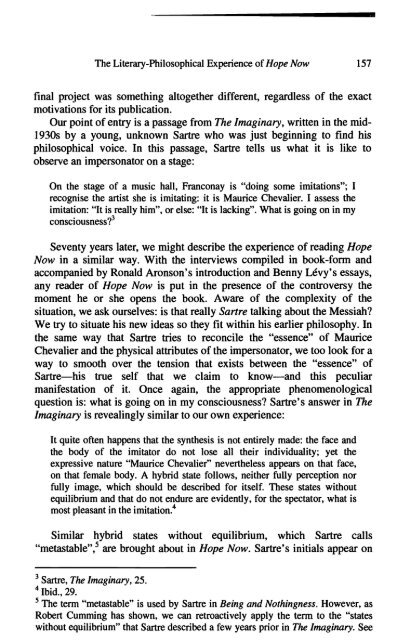Sartre's second century
Sartre's second century
Sartre's second century
Create successful ePaper yourself
Turn your PDF publications into a flip-book with our unique Google optimized e-Paper software.
The Literary-Philosophical Experience of Hope Now 157<br />
final project was something altogether different, regardless of the exact<br />
motivations for its publication.<br />
Our point of entry is a passage from The Imaginary, written in the mid-<br />
1930s by a young, unknown Sartre who was just beginning to find his<br />
philosophical voice. In this passage, Sartre tells us what it is like to<br />
observe an impersonator on a stage:<br />
On the stage of a music hall, Franconay is "doing some imitations"; I<br />
recognise the artist she is imitating: it is Maurice Chevalier. I assess the<br />
imitation: "It is really him", or else: "It is lacking". What is going on in my<br />
consciousness? 3<br />
Seventy years later, we might describe the experience of reading Hope<br />
Now in a similar way. With the interviews compiled in book-form and<br />
accompanied by Ronald Aronson's introduction and Benny Levy's essays,<br />
any reader of Hope Now is put in the presence of the controversy the<br />
moment he or she opens the book. Aware of the complexity of the<br />
situation, we ask ourselves: is that really Sartre talking about the Messiah?<br />
We try to situate his new ideas so they fit within his earlier philosophy. In<br />
the same way that Sartre tries to reconcile the "essence" of Maurice<br />
Chevalier and the physical attributes of the impersonator, we too look for a<br />
way to smooth over the tension that exists between the "essence" of<br />
Sartre—his true self that we claim to know—and this peculiar<br />
manifestation of it. Once again, the appropriate phenomenological<br />
question is: what is going on in my consciousness? <strong>Sartre's</strong> answer in The<br />
Imaginary is revealingly similar to our own experience:<br />
It quite often happens that the synthesis is not entirely made: the face and<br />
the body of the imitator do not lose all their individuality; yet the<br />
expressive nature "Maurice Chevalier" nevertheless appears on that face,<br />
on that female body. A hybrid state follows, neither fully perception nor<br />
fully image, which should be described for itself. These states without<br />
equilibrium and that do not endure are evidently, for the spectator, what is<br />
most pleasant in the imitation. 4<br />
Similar hybrid states without equilibrium, which Sartre calls<br />
"metastable", 5 are brought about in Hope Now. <strong>Sartre's</strong> initials appear on<br />
3<br />
Sartre, The Imaginary, 25.<br />
4<br />
Ibid., 29.<br />
5<br />
The term "metastable" is used by Sartre in Being and Nothingness. However, as<br />
Robert Cumming has shown, we can retroactively apply the term to the "states<br />
without equilibrium" that Sartre described a few years prior in The Imaginary. See
















